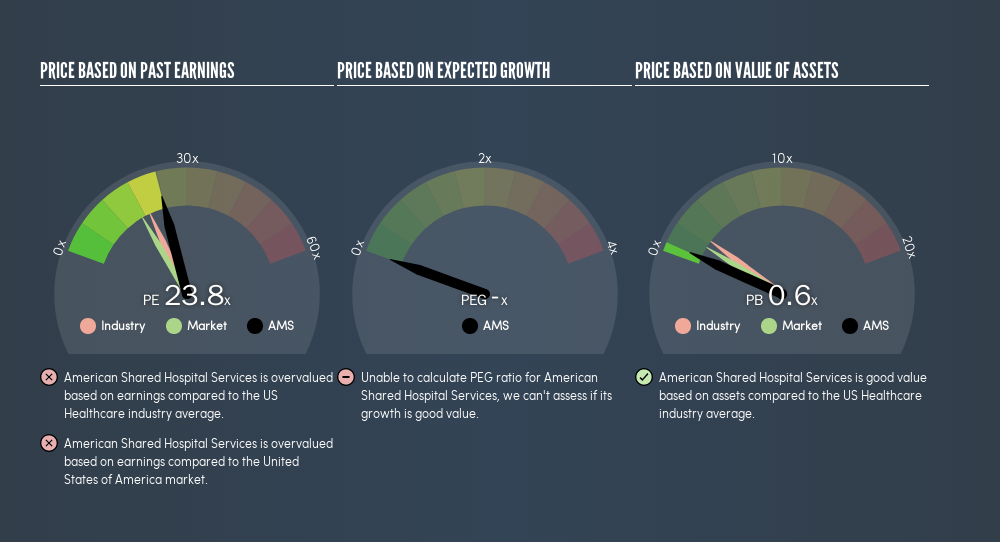- United States
- /
- Healthcare Services
- /
- NYSEAM:AMS
Should You Be Tempted To Sell American Shared Hospital Services (NYSEMKT:AMS) Because Of Its P/E Ratio?

This article is written for those who want to get better at using price to earnings ratios (P/E ratios). We'll look at American Shared Hospital Services's (NYSEMKT:AMS) P/E ratio and reflect on what it tells us about the company's share price. American Shared Hospital Services has a price to earnings ratio of 23.8, based on the last twelve months. That is equivalent to an earnings yield of about 4.2%.
View our latest analysis for American Shared Hospital Services
How Do I Calculate A Price To Earnings Ratio?
The formula for P/E is:
Price to Earnings Ratio = Price per Share ÷ Earnings per Share (EPS)
Or for American Shared Hospital Services:
P/E of 23.8 = $2.63 ÷ $0.11 (Based on the trailing twelve months to June 2019.)
Is A High Price-to-Earnings Ratio Good?
The higher the P/E ratio, the higher the price tag of a business, relative to its trailing earnings. That isn't a good or a bad thing on its own, but a high P/E means that buyers have a higher opinion of the business's prospects, relative to stocks with a lower P/E.
Does American Shared Hospital Services Have A Relatively High Or Low P/E For Its Industry?
The P/E ratio essentially measures market expectations of a company. You can see in the image below that the average P/E (19.3) for companies in the healthcare industry is lower than American Shared Hospital Services's P/E.

That means that the market expects American Shared Hospital Services will outperform other companies in its industry.
How Growth Rates Impact P/E Ratios
Earnings growth rates have a big influence on P/E ratios. If earnings are growing quickly, then the 'E' in the equation will increase faster than it would otherwise. That means even if the current P/E is high, it will reduce over time if the share price stays flat. So while a stock may look expensive based on past earnings, it could be cheap based on future earnings.
American Shared Hospital Services's earnings per share fell by 71% in the last twelve months. But over the longer term (3 years), earnings per share have increased by 9.8%.
Remember: P/E Ratios Don't Consider The Balance Sheet
The 'Price' in P/E reflects the market capitalization of the company. In other words, it does not consider any debt or cash that the company may have on the balance sheet. In theory, a company can lower its future P/E ratio by using cash or debt to invest in growth.
Spending on growth might be good or bad a few years later, but the point is that the P/E ratio does not account for the option (or lack thereof).
How Does American Shared Hospital Services's Debt Impact Its P/E Ratio?
American Shared Hospital Services's net debt is 17% of its market cap. It would probably deserve a higher P/E ratio if it was net cash, since it would have more options for growth.
The Bottom Line On American Shared Hospital Services's P/E Ratio
American Shared Hospital Services trades on a P/E ratio of 23.8, which is above its market average of 17.1. With some debt but no EPS growth last year, the market has high expectations of future profits.
Investors have an opportunity when market expectations about a stock are wrong. People often underestimate remarkable growth -- so investors can make money when fast growth is not fully appreciated. We don't have analyst forecasts, but you might want to assess this data-rich visualization of earnings, revenue and cash flow.
But note: American Shared Hospital Services may not be the best stock to buy. So take a peek at this free list of interesting companies with strong recent earnings growth (and a P/E ratio below 20).
We aim to bring you long-term focused research analysis driven by fundamental data. Note that our analysis may not factor in the latest price-sensitive company announcements or qualitative material.
If you spot an error that warrants correction, please contact the editor at editorial-team@simplywallst.com. This article by Simply Wall St is general in nature. It does not constitute a recommendation to buy or sell any stock, and does not take account of your objectives, or your financial situation. Simply Wall St has no position in the stocks mentioned. Thank you for reading.
About NYSEAM:AMS
American Shared Hospital Services
Provides technology solutions for stereotactic radiosurgery and advanced radiation therapy equipment and services.
Proven track record with adequate balance sheet.
Similar Companies
Market Insights
Community Narratives





